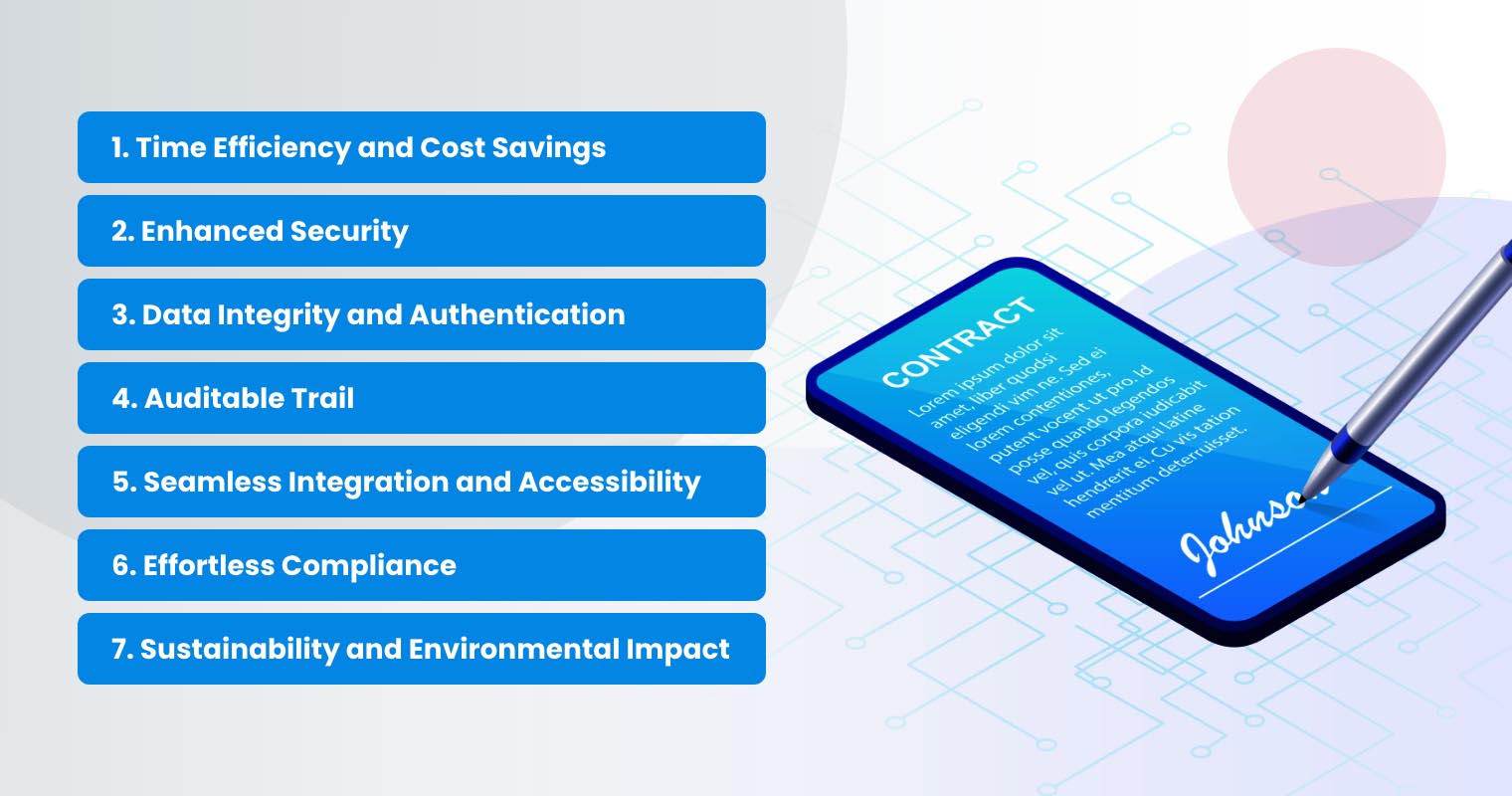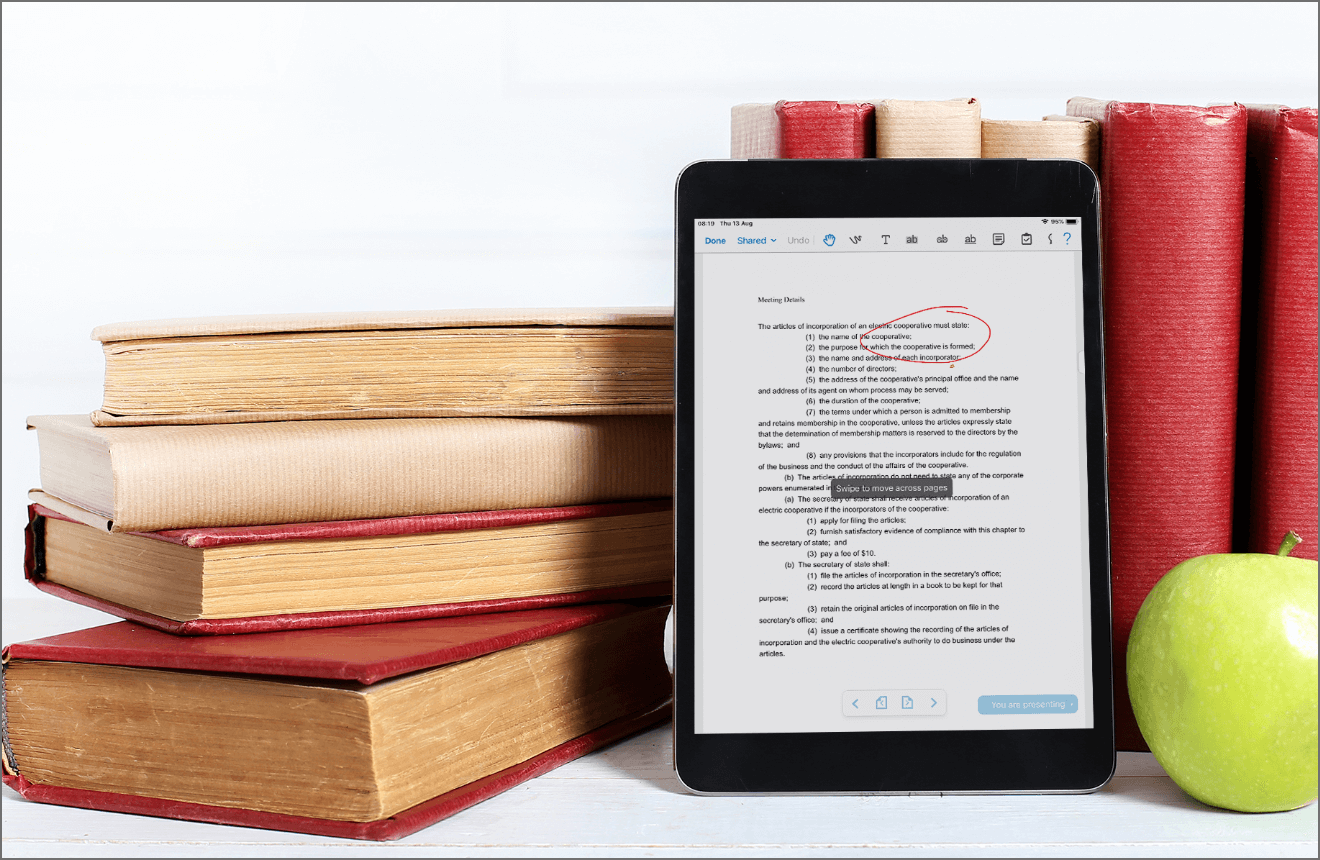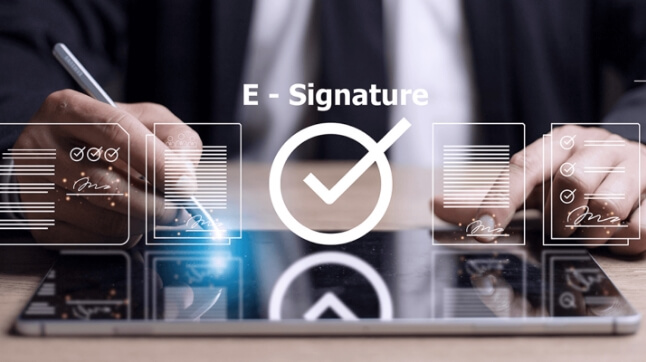Key Takeaways:
- An e-signature is a secure digital method of signing documents, often verifying identity and without the hassle of physically signing papers.
- On the other hand, a digital signature provides an extra layer of security, demanding digital certificates and encryption keys, and is used in legally binding contracts and transactions.
- An electronic signature works by using cryptographic techniques to create an encrypted digital fingerprint linking the signer’s identity to the document to ensure authenticity and integrity.
- Some of the benefits of digital signatures are time efficiency and cost savings, a higher level of security, data integrity, enhanced accessibility, compliance, and being more eco-friendly than paper-based signatures.
- Convene board portal offers its Digital Signature Suite with tools such as eSignature, Sign Auth, and third-party provider integration, allowing for seamless, compliant, and secure digital signing.
The shift of the boardroom setup from physical in the pre-pandemic to remote in the pandemic has accelerated the trends in the digital transformation of the board. The primary focus now of the boardroom directs on data security, remote collaboration, and seamless meetings. Organizations have switched to platforms and tools that enhance their virtual meeting experience and simplify their tasks — one of which is signing documents.
What is Electronic Signature?
An electronic signature, often referred to as an e-signature, stands as a digital portrayal of an individual’s intention to authenticate or endorse a document, contract, or agreement. It represents a digital departure from the traditional method of physically signing papers, making it possible for individuals to sign and submit documents regardless of their location.
These digital signatures come in various forms, spanning from manually typing one’s name in a designated field to utilizing specialized software to create a unique digital rendition of one’s signature. Some methodologies might even incorporate cryptographic techniques to guarantee the credibility and unaltered state of the signed document. At its core, electronic signature offers a secure and streamlined avenue for digitally affirming consent or permission.
Digital Signature vs Electronic Signature
Digital and electronic signatures are two distinct methods used for validating digital documents and agreements — differing in their technical aspects, security measures, and legal implications. Learn about the difference between electronic and digital signatures below:
What is eSignature?
An electronic signature is a broader concept, encompassing various methods to indicate consent or authorization in digital documents. This includes typing one’s name, pasting a scanned signature, clicking an “I agree” button, or using biometric authentication like fingerprints or facial recognition. Electronic signatures focus on confirming intent to sign rather than the complex cryptographic security of digital signatures. While legally valid in many contexts, their security level may vary based on the method used.
What is digital signature?
A digital signature is a cryptographic technique utilized for signing documents. Designed to give an extra layer of security, it uses a sophisticated algorithm to create a unique digital fingerprint of the document. This hash is encrypted with the signer’s private key to generate the digital signature. Recipients can verify it using the signer’s public key, ensuring document integrity and the signer’s identity. Digital signatures provide heightened security and are commonly used for critical and legally binding documents.
Key Differences Between Electronic and Digital Signature:
- Cryptographic Process: Digital signatures use complex algorithms for creation and verification; electronic signatures involve simpler actions.
- Legal Status: Digital signatures are often legally equivalent to handwritten signatures, especially for important contracts. Electronic signatures’ legal recognition varies.
- Use Cases: Digital signatures are common for legally binding contracts, transactions, and documents requiring high security. Electronic signatures are versatile and fit various scenarios, including less formal agreements.
- Complexity: Digital signatures demand intricate setups with digital certificates and encryption keys; electronic signatures are generally easier to implement.
While digital signatures excel in security for critical transactions, electronic signatures offer flexibility for various cases.
Benefits of Electronic Signature

Incorporating electronic signatures into business operations offers a plethora of benefits. It doesn’t only modernize processes but also elevate the efficiency of companies today. Read on to know more about the benefits of electronic signatures.
1. Time Efficiency and Cost Savings
Utilizing electronic signatures streamlines the signing process and eliminates the need for physical presence or postage delays. This expedites transactions, saving valuable time for all parties involved. Additionally, the reduction in paper usage translates into cost savings for printing, shipping, and storage.
2. Enhanced Security
Among the benefits of electronic signature is that it incorporates encryption and authentication measures. That said, it is deemed to offer a higher level of security than traditional paper-based signatures. Implementing electronic signatures can prevent unauthorized access, tampering, or forgery of signed documents.
3. Data Integrity and Authentication
Electronic signatures maintain the integrity of documents throughout their lifecycle. Any alterations made after the signature are detectable, ensuring the authenticity and unaltered state of the signed content. Furthermore, signatories’ identities are verified through authentication processes, enhancing trust and accountability.
4. Auditable Trail
The use of electronic signature gives users access to solutions that provide comprehensive audit trails, which track the entire signing process. This includes timestamps, IP addresses, and actions taken by signatories. Such detailed records enhance transparency, mitigate disputes, and comply with regulatory requirements.
5. Seamless Integration and Accessibility
Electronic signature platforms can seamlessly integrate with existing workflows and software applications, simplifying the incorporation of electronic signatures into various processes. This accessibility enables users to sign documents from anywhere, fostering remote collaboration and expediting approvals.
6. Effortless Compliance
Electronic signatures enable easy adherence to various regulations and legal requirements. E-signature software, for instance, offers tools for tracking and recording signature activities, making it simpler to demonstrate compliance with audit trails and documentation standards.
7. Sustainability and Environmental Impact
By reducing paper usage and the need for physical transportation, e-signatures contribute to a more eco-friendly approach. This leads to a more sustainable practice, helping to minimize the carbon footprint associated with traditional paper-based signatures.
Legal Validity of Electronic Signatures
In today’s modern business landscape, the credibility and legal standing of e-signatures are imperative. There are three pivotal legislations that lay the groundwork for recognizing e-signatures as legally binding tools of authentication. Learn about them below:
Electronic Signatures in Global and National Commerce (ESIGN) Act
Enacted by the U.S. Congress in 2000, the ESIGN Act serves as a federal law designed to facilitate the use of electronic signatures and records in both interstate and international commerce. Under this legislation, e-signatures are conferred with equal legal validity as their traditional ink-and-paper counterparts.
The ESIGN Act stipulates that contracts and records cannot be invalidated solely based on their electronic format, ensuring digital transactions hold the same weight and enforceability as paper counterparts.
The essence of the ESIGN Act resides in its emphasis on consent. It mandates that all parties involved in electronic transactions must willingly agree to engage in business electronically. This consent requirement underscores the importance of informed participation and ensures that electronic signatures are not employed inadvertently or under duress.
Electronic Transactions Act
In Singapore, the use of electronic signatures has been recognized by the government under the Electronic Transactions Act (Cap.88) (ETA). Authorities are now providing a legal foundation for the enactment of electronic signature and the promotion of its use. According to Singapore’s Infocomm Media Development Authority (IDMA), accepted signatures should take the following, but not limited to these, formats:
- Digitized image of the physical signature
- Drawn signature on an electronic device
- Clicked “I agree” to terms and conditions
- Generated signature from e-signature software
However, the ETA also emphasizes using secure electronic signatures, requiring digital certificates and meeting verification conditions like: the signature’s uniqueness, correlation to the signee, creation during the certificate’s validity, and issuance by an accredited certification authority.
Uniform Electronic Transactions Act (UETA)
The Uniform Electronic Transactions Act, proposed by the National Conference of Commissioners on Uniform State Laws (NCCUSL) in 1999, provides a model framework for states to adopt and incorporate into their own laws. The UETA aims to establish uniformity across jurisdictions in recognizing electronic signatures and records as valid instruments for conducting business.
Operating under the capacious umbrella of the ETA, the Infocomm Media Development Authority (IMDA) outlines accepted formats for electronic signatures. These formats include a digitized image of a physical signature, signatures drawn on electronic devices, agreements signified by clicking “I agree,” and generated signatures from specialized e-signature software.
Like the ESIGN Act, the UETA defines the legal effect of electronic signatures in contractual transactions. A significant aspect of the UETA is its “functional equivalence” principle, which asserts that an electronic record or signature should be treated on par with its traditional paper-based counterpart if it serves the same purpose.
Implementing Electronic Signatures with Board Software

Implementing the use of e-signatures requires software that can both streamline the signing process and secure documents and signatures. Tailored to do just that, Convene Signature Suite offers signature and initials functionalities for seamless compliance with both internal and external signature regulations.
Convene eSignature enables effortless signing of resolutions, minutes, and other documents in the Convene App with a single tap, eliminating the complexity of juggling multiple signing apps. Users also get to take advantage of instant signature synchronization and signature storage.
To streamline the signing process, Convene Sign Box allows directors to swiftly locate designated signing areas through placeholders, enhancing efficiency and accuracy. Convene Sign Auth, on the other hand, ensures authorized signing through Biometric Authentication or Two-Factor Authentication methods. The signature suite also provides a Sign Trail that audits all the signatures and initials made on every document.
Companies with a digital signature solution in place can still opt to integrate with Convene for a seamless signing system. Legally enforceable third-party digital signature providers, such as DocuSign and SingPass, can be integrated with Convene.
Frequently Asked Questions About Using Electronic Signatures
Navigating the intricacies of e-signatures often raises questions, and here are some of the top FAQs to know when using electronic signatures:
Can electronic signatures be forged easily?
No, electronic signatures are designed to deter easy forgery through encryption and authentication protocols. With such measures, unauthorized replication of the e-signatures will be considerably difficult.
How to add an electronic signature to a document?
Adding an e-signature into a document typically involves the use of specialized software or dedicated applications. Such tools have features that can directly add, draw, or even upload scanned images of handwritten signatures. Opt for software such as Convene that adheres to legal requirements and security standards.
How do electronic signatures work?
Electronic signatures operate through cryptographic techniques: when a signer applies their signature, a digital fingerprint of the document’s content is generated and encrypted along with their identity using a unique key. This encrypted data is then attached to the document, allowing recipients to verify the document’s integrity and the signer’s identity.
Can e-signatures be used for sensitive transactions?
Absolutely, e-signatures can be employed for sensitive transactions, including those in the finance and healthcare sectors. However, to ensure the confidentiality and integrity of such transactions, robust security measures must be in place. These measures often encompass stringent authentication mechanisms and encryption protocols.
What role does encryption play in electronic signatures?
Encryption plays a pivotal role in protecting the document’s integrity and the privacy of the signer. Once a document is electronically signed, encryption is applied to prevent unauthorized access or tampering. Only authorized individuals with requisite decryption keys can access and verify the document’s contents and signature.
Document Sign-off Made Easy With Convene

The digital transformation of the boardroom grants streamlined processes necessary for remote work and the demands of the digital society. Traditional document signing may not be the best option for achieving effective document approvals. With Convene, directors and executives can instantly sign documents in just a few clicks through an electronic meeting system.
Convene is a one-stop board portal that provides all the tools needed to execute board activities, from virtual board meetings to document reviews and sign-offs. It is designed to help fulfill the board’s responsibilities that demand compliance, transparency, accountability, and security.
Experience the efficiency and security of digital signature with a one-stop board portal software. Discover Convene now and book a demo.
Audrey is a Content Marketing Specialist at Convene, in charge of managing the production of quality content on the company’s website. A communication major keen on marketing, Audrey has been constantly seeking approaches to create tailored content—may it be about governance, digitalization, boards, or meetings—fit for the stakeholders. When not strategizing on the next ebook to produce, Audrey finds solitude in reading make-you-ugly-cry novels and listening to self-improvement podcasts.











